
FasterSkier’s coverage of the 2015 FIS Nordic World Ski Championships in Falun, Sweden, is brought to you by the generous support of L.L. Bean, now featuring a complete line of Kikkan Randall training wear.
FALUN, Sweden– With two medals in the 10-kilometer freestyle race two days ago here at World Championships, both internal and external pressure was high on the women of the U.S. Ski Team to climb the podium in Thursday’s 4 x 5 kilometer relay.
They had been there before, at least in World Cup racing, when the Americans placed third in the same event in Gällivare, Sweden, in December 2012. But since then, they had won World Championships gold in the team sprint in 2013 and had best-ever individual performances by almost every member of the team.
And so the Americans went into the relay raring to go.
“You can say that you believe in yourself, but to actually believe in yourself is an entirely different thing,” U.S. Ski Team women’s coach Matt Whitcomb said. “I think some of these results earlier in the week, our top 10’s, our top 15’s, our podiums, have really allowed not just those who acquired the results, but those who are connected to them on the team, close to them, to feel that confidence. This is a team that really believes in themselves.”
Things didn’t go smoothly straight out of the gate, with leadoff skier Sadie Bjornsen crashing on an uphill and losing contact with the leaders. But despite that, the team fought their way back to fourth place, 1:49.9 behind the winning Norwegian team and just ahead of Poland and Germany, who had been in contact on the final loop.
“It can be hard, especially last night when you know that there’s a huge opportunity ahead of you, it can really shut you down, the pressure,” said Jessie Diggins, who anchored the relay. “I think we rose up and met it, and I think we can be really proud of that… To be fourth in the world on a day when not everything went perfectly, is something I think we can be really proud of.”
A Rough Start
Bjornsen was embedded in a tight lead pack for the first loop of the tough 2.5 k classic course. Skiing in fourth, she was aggressive and also handling skis which she described as the fastest in the field. Halfway through her 5 k assignment Bjornsen was sitting in fourth place when Anastasia Dotsenko of Russia skied over the tips of her skis on the short, steep uphill in the stadium.
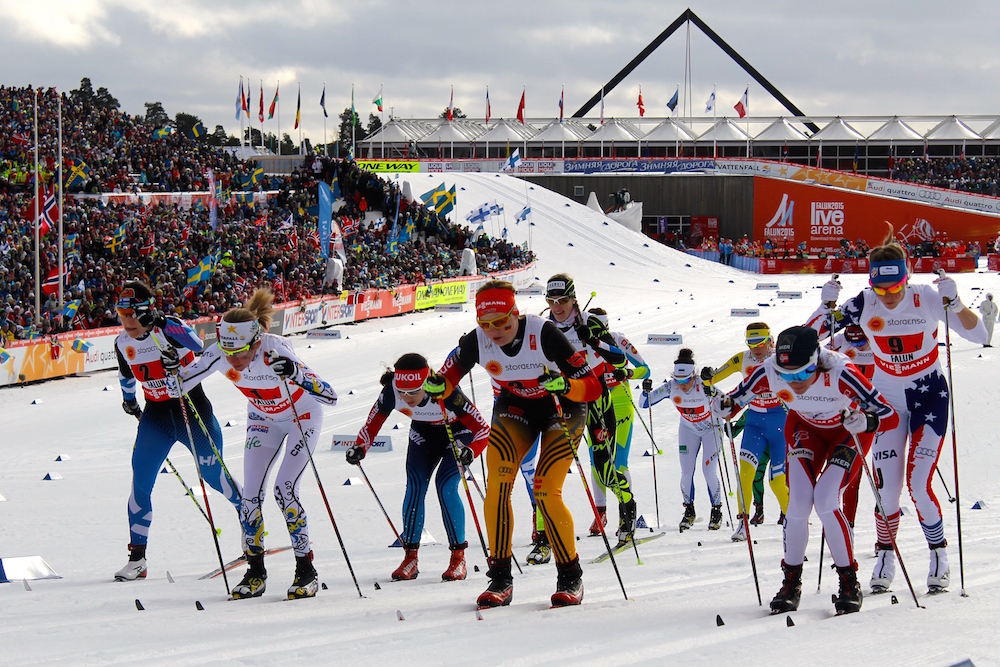
“Russia just kind of went over the top of my front ski, and spun me around,” she said. “It was in a spot where it was high speed, so it was not ideal. I was feeling great. I was ready to chase with them.”
It was a fateful moment not only for Bjornsen, but for the rest of the field as well. The women had been tightly packed, but because Bjornsen’s fall created chaos in the middle of the group, a gap suddenly opened to the leading two teams, Russia and Finland. While Heidi Weng of Norway and Sofia Bleckur of Sweden were eventually able to recover and bridge that gap, the field had fractured sooner than it otherwise might have.
For Bjornsen, it was tough to fully recover. She initially made up some of the ground she had lost, but by the time she tagged off she was 50 seconds behind Aino-Kaisa Saarinen of Finland.
“Initially I went really hard, and then flooded pretty badly,” Bjornsen said. “So it was hard to come back on.”
When she made it to the tag zone, she handed off to Alaska Pacific University teammate Rosie Brennan. The SuperTour leader through the first period of racing, Brennan qualified for her first World Championships by dint of her domestic racing so far this season.
“I was really nervous,” she said. “But I was really excited to be part of the relay. It’s just really awesome privilege.”

While the gap to the leaders grew by 50 seconds under Brennan’s watch – Therese Johaug of Norway seized the lead from Finland and put on a show, caught only by Sweden’s Charlotte Kalla – Brennan moved the team up from sixth to fifth by passing Alevtina Tanygina of Russia. She had a powerful motivator ahead of her: Justyna Kowalczyk of Poland, one of the world’s best classic skiers.
“Kowalczyk was the one who tagged in front of me, so I went out as hard as I could to try to get on the back of her, thinking maybe I could catch a sweet ride,” Brennan explained. “I wasn’t quite that fast, so I just tried to keep her in my eyesight the whole time. Then we caught that Russian girl, so I just tried to put a big enough gap on her so she wouldn’t come back on the downhill.”
When Brennan tagged off, she was 38 seconds behind Poland and in fifth place. Whitcomb was impressed by both Bjornsen’s and Brennan’s performances: one had crashed and the other was in her first senior-level relay ever, and the team was still fifth.
“It’s pretty impressive to see how close she was able to stay,” he said of Bjornsen. “I’m really impressed with her ability to crash, freak out a little bit, and then land right away. She just got up, stayed cool, and it’s a testament to a championship racer.”
And after that, it would have been easier for the gap to the leaders to grow even more. But Brennan kept things under control.
“It’s really cool to see Rosie in her first relay start be part of a fourth-place result,” Whitcomb said. “We’ve had days where we lose contact after one lap and that space that opens up and you’re in no draft. And those skiers ahead of you, if they’re packed up, they are going away from you fast. So that could have opened up to three minutes, but she kept it.”
That left the race up to the Americans’ habitual anchors, Liz Stephen and Diggins.
Skating to Success
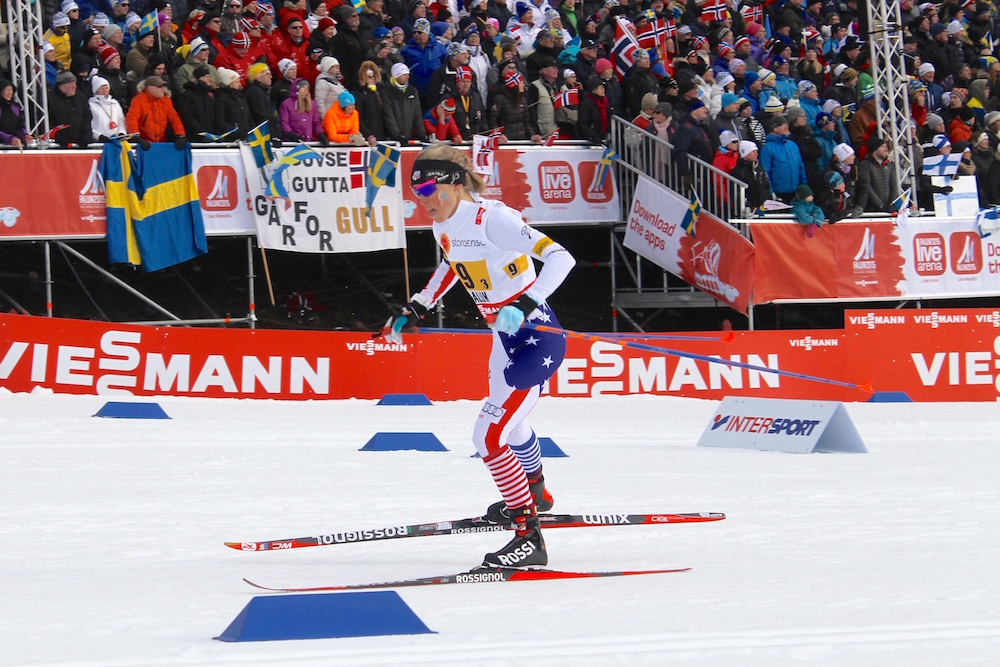
While the climbs in the classic leg had gone on and on, with Bjornsen and Brennan climbing up “little Mörderbacken,” Stephen and Diggins had less time to work with as they tried to make up time on the leaders. The skate course was 2.4 k compared to 2.8 k on the classic course, and the biggest climb was only half the size.
That corresponded to ski times only 2/3 as long: while the classic legs were 14 or 15 minutes, Stephen and Diggins had only 10 minutes to work with each, as they tried to make up an almost two-minute gap to the leaders. A podium seemed out of the question.
“Short, so short!” Stephen said. “I had two V1 hills to hop the crap out of and I felt great on the ups. It was awesome to have Denise Herrmann [of Germany] lead that first section through the wind. I skied my hardest and my heart out.”
Stephen’s time was only one second off the fastest split for her leg – taken by Herrmann, who had moved up to catch her on the earlier part of the loop. But by the finish, Stephen had put three seconds into the German and made up time on the fourth-place team from Poland. The U.S. was now only six seconds out of fourth place.
“Every relay, no matter where we are, I’m fighting to get the next person,” Stephen said. “When I get that person I fight to get the next person. I think I say it everytime, but the game of tag is my favorite game of all time. I love just going to play tag out there. So I was just focusing on going past Germany and going past Poland and just getting there as fast as possible.”
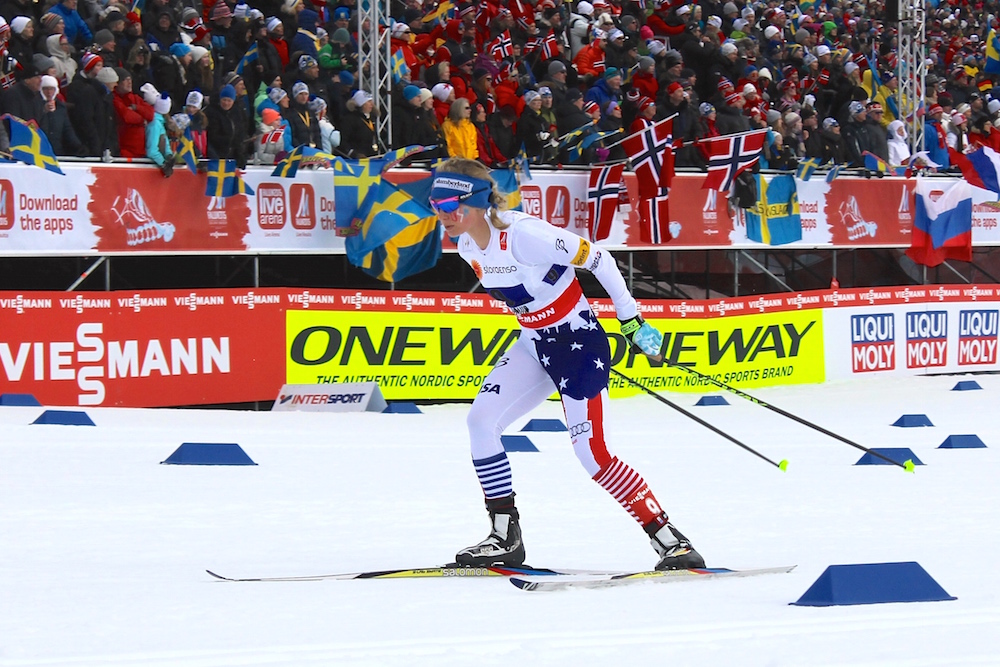
While the gradual profile didn’t fit Stephen’s traditional strengths – climbing on her skate skis – in a way, it was perfect.
“It’s a very low-profile and fast course, but that’s not to say that it’s easy,” Whitcomb said. “Liz is so fit right now. People will go out and try to jam on this course, and as soon as they start getting tired Liz will find that chink in the armor and destroy them. She came back from 40 seconds to within six of Poland, and as soon as she saw them, that’s like a magnet at work.”
With Poland ahead of her and Germany behind, Diggins set off as she usually does: pedal to the metal, trying to drop the competition. But after a lap, when she had caught but not dropped Sylwia Jaskowiec of Poland, and Nicole Fessel of Germany had also caught up, Diggins had to change her strategy.
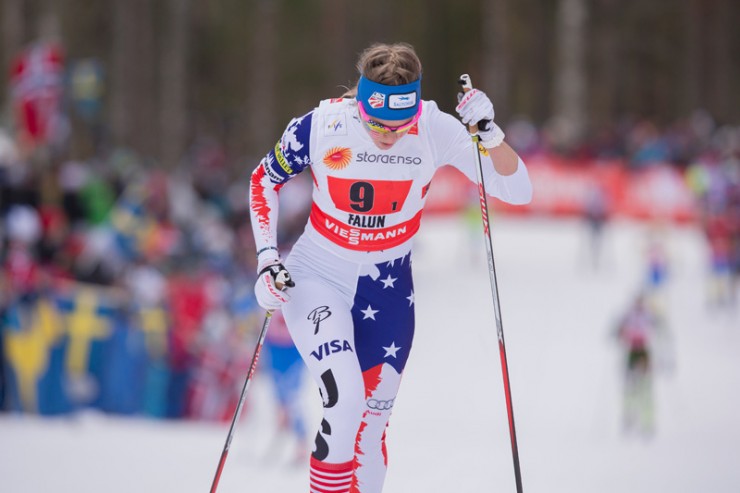
“I tried to make them lead, and when they wouldn’t lead, I just stood up,” Diggins explained. “I knew I would recover fast on the downhill. I pretended, OK, it’s the last leg of the team sprint. If you can recover coming into that, and then make a move on the second hill and try to drop them, I knew our skis would be fast, I have a shot at this.”
On the last uphill before the stadium she put in a move, dropping both Jaskowiec and Fessel. She kept that lead into the stadium, up over the final hill, and into the finish line, to secure fourth place by 2.4 seconds over Jaskowiec. It tied the Americans’ best ever relay result.
“I love the chase,” Diggins said, echoing Stephen. “So I was just gunning [Jaskowiec] down… It was really cool to have that chase right there because it just gets you really fired up. I was just hoping I don’t blow up. There was a very real chance.”
Diggins credits the tactics she used to a lot of experience gained since she first anchored a U.S. relay in 2011.
“For sure at first the tactic was ‘head down and hammer’ and sometimes I’d blow up and it wouldn’t work,” she admitted. “Now I’ve definitely started gaining experience, so looking over my shoulder, there’s nobody behind us, I can slow down. I don’t need to pull these girls, I can pass them at the end. Whereas before, I would have been just keep trying to drop them, no matter what. Definitely, as I’m ‘getting older’, I’m getting it.”
U.S. Ski Team Head Coach Chris Grover agreed that he was thrilled to see the added maturity in Diggins’ racing, so that she could make the most of her fitness and skate power.
“I think everyone was excited to see Jessie to ski so tactically well at the end,” Grover said. “She went out with Germany and Poland and both of those women are great sprinters. You knew it could be a really big fight at the line if it came to that. Jessie was incredibly smart to try to pull over and let [Jaskowiec] take the lead. She wouldn’t, so Jessie slowed down the pace and regrouped a little bit so she could make some moves at the end. Incredibly tactically smart race.”
Team Takeaways
The four-woman combination was completely new for the Americans, but Grover felt it was the right one.
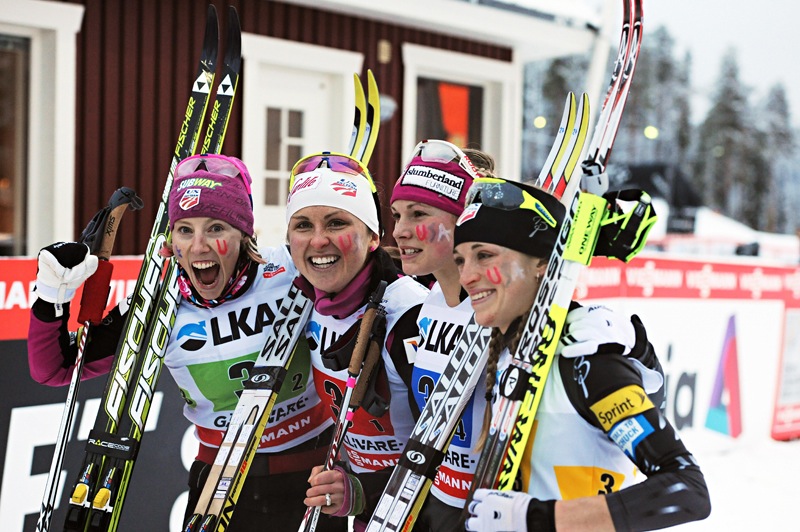
“I’m really excited about how all four of those ladies skied,” he said. “They skied their hearts out and I’m really confident that we put together the strongest team, in the right legs, that we could have.”
While Stephen and Diggins were set in their team positions, the squad had done some serious thinking before placing Bjornsen in the first leg and Brennan in the second. It had worked out perfectly, though, Whitcomb thought.
“We were wondering if we should have Rosie scramble and Sadie go second,” Whitcomb explained. “Usually we put our strongest classic skier second because they can cover the most distance. But Rosie has shown that she’s really great at chasing people down. She crashed out of the mass start in the 15 k and was able to catch back up to Sadie and Liz. So that coupled with the fact that she doesn’t really love skiing with people on the descents, she could just be out there putting the hammer down, throwing the eyes into the back of the head, and going.”
Bjornsen was disappointed that her crash had created the initial gap to the leaders, but happy with what her teammates were able to accomplish.
“I am so incredibly impressed with my team,” she wrote in an e-mail later in the evening. “They fought really hard, and did incredible. I was so happy to see Rosie come into her first relay and do incredible too! Super cool. I am bummed that I had that little catch up that maybe lost an opportunity to chase with that first pack of three for longer… but it never works out just perfect on relay days… so that is life! We are happy to have finished so close to that podium, and we will be there again soon!”
Another takeaway from Grover is that while the team knew that a medal was possible, they also knew that things weren’t set up perfectly for them. Norway and Sweden would be tough to beat, and the race itself didn’t favor the Americans’ strengths. For instance, Stephen’s uphill specialization went unused on the relatively mild skate course.
“It was a little bit of a challenging day, and we knew it would be, in that the classic course is so much harder than the skate course,” he said. “So it really stacked it in favor of the classic skiers. Which is why you saw Kalla take the second leg for Sweden. For us in the U.S.A., we’re a little bit of a stronger skate nation, so to have a course that’s a little bit stacked in favor of classic, I think really favored the Scandinavians.”
In some ways fourth place is the toughest result to have – a “wooden medal” – but Grover pointed out that the team had been there before, notably at the 2013 World Championships relay in Val di Fiemme, Italy. He hoped the result could be motivating and not just disappointing.
So did Whitcomb.
“We know that if we can be within 20 seconds of third place tagging off onto our third leg, we can be in it,” he said. “Today was a little bit too much but I’m really excited that we didn’t end up sixth. Or ninth, like [the 2014 Olympics in] Sochi. Fourth place is such a success, and I’m absolutely thrilled.”
According to the women on the team, the motivation is still there, stronger than ever.
“I think all of us keep dreaming for that podium,” Stephen said. “And the fact that we’re not on it today makes us able to dream again for the next time. I’m really proud of all the girls on this relay team and the team as a bigger team. To have two girls on the podium the other day, I think we’re trying to ride the high. We all skied the best we possibly could today. I’m already dreaming for the next chance at a podium.”
Chelsea Little
Chelsea Little is FasterSkier's Editor-At-Large. A former racer at Ford Sayre, Dartmouth College and the Craftsbury Green Racing Project, she is a PhD candidate in aquatic ecology in the @Altermatt_lab at Eawag, the Swiss Federal Institute of Aquatic Science and Technology in Zurich, Switzerland. You can follow her on twitter @ChelskiLittle.



